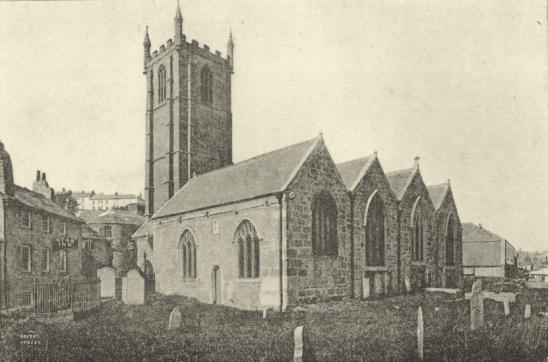The following text is lifted directly from [Matthews 1892]. It must be read in the context of that date.

ST. IVES CHURCH, FROM SOUTH-EAST.
- I. A Physical
Description of the Saint Ives District.
Mineralogy—Flora and Fauna—Agriculture—Climate—Ethnology. - II. Prehistoric, British and Roman
Periods.
Where are the Cassiterides?—Evidence afforded by the Saint Erth Valley—Hill forts, cliff castles and hut dwellings—Reliques of the giants—Cromlechs, logan-rocks and stone circles—Roman remains. - III. The Introduction of
Christianity to the Saint Ives District.
Irish and Welsh missionary saints—Saint Ia, her life, labours and martyrdom—History of the name ‘St. Ives’. - IV. The Early Christian Antiquities
within the District of Saint Ives.
Chapels, crosses and holy wells—The inscribed stone at Trevarrack. - V. of the Manors and
Lordships.
Ludgvan Lese, Dinas Ia and Porthia, Saint Ives and Treloyhan, Porthia Prior, Trenwith, Lelant and Trevetho, Trembethow, Amalibria, Boswednack, Treen, Trewey, Kerrow and Cornello, and their owners—Ancient conveyances of land—Saint Ives in the fourteenth and fifteenth centuries—The Subsidy Roll of 1327—Field-names—The Plain-an-Gwarry and the miracle plays. - VI. The Parish Church of Saint
Ives.
How Saint Ives became a parish—The building of the church—Full description of the fabric—Gargoyles and grotesques, what do they signify?—The stone and wood carving—The Trenwith brass and other sepulchural monuments in the church—Saint Ives cross—The consecration and dedication of Saint Ives Church—The services before, during, and after the Reformation—The bells—The church plate and other furniture—The Parish Registers and Churchardens’ Book—Gravestone inscriptions in the churchyard and cemeteries. - VII. The Churches of Lelant, Towednack and
Zennor.
1. Lelant Church—Ancient grants thereto—Full description of the fabric—King Charles’ letter of thanks—Pre-Reformation clergy—Sepulchral monuments in church and churchyard.—2. Towednack Church—Description of the fabric—Sepulchral monuments.—3. Zennor Church—Description of the fabric before and since the restoration of 1890—The mermaid of Zennor—Post-Reformation vicars—Sepulchral monuments. - MORE TO COME SOON

 Webmaster
Webmaster